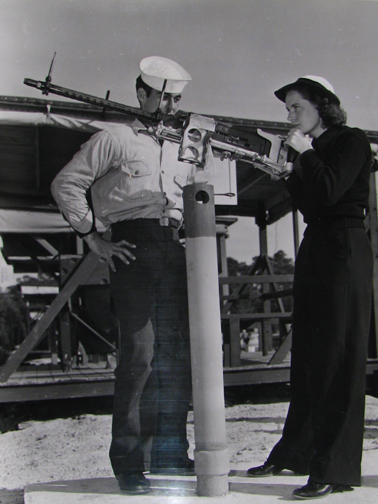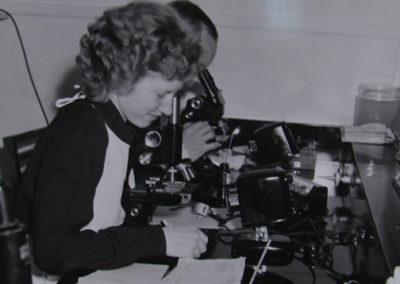On the Job
Initially, just three jobs were open to women in the Navy: yeomen (secretarial work), storekeepers (bookkeeping), and radio communications. By late-1943, that list had expanded to 246 different job categories, including Link trainer instructor (training pilots in instrument flying), Aerographer’s Mate (weather forecasting), and carrier pigeon raising (a single class of recruits who learned how to breed and train carrier pigeons).
On the Job
WAVES Work
The first WAVES were on the job in late 1942. And they found that while they were well prepared for Naval work, the Navy wasn’t always well prepared for WAVES. That would change as more women graduated from specialty training schools and the bases got accustomed to women working alongside men.
Facts and Figures
Eighteen percent of the Navy’s personnel assigned to shore duty during World War II were WAVES. While the vast majority were yeomen or storekeepers, there were also 23,000 women serving in the Bureau of Aeronautics. Another 13,000 women were in the formerly all-male Hospital Corps in a variety of positions, including 42 as physicians and two as dentists.
Unique Jobs
Each woman interviewed for this project described herself as doing something unique for the time. Those who worked in the “glamour” jobs as aerographers, machinists, link trainers, gunnery instructors, etc. found uniqueness through their work, which they couldn’t do in the outside world.
Those working jobs similar to the civilian world (yeomen, storekeepers) described themselves as being unusual within the military group. They were the first, or only, woman to be placed in a particular situation or they experienced specific things away from the job which set them apart from not only civilians, but also from the rest of the WAVES and SPARs.
Addressograph
I ran an addressograph machine. Now, they don’t even know what those are in this day and age. It was a forerunner of the computer. We would type out addresses and they would come out on a little metal plate. There was a rack that the metal plate fits in. Run the envelopes through it and address ’em. We did it for all the Coast Guard stations and lot of the district offices and stuff. Part of the time we delivered mail . . . Oh, and our most important thing of all [laughs]. If somebody was dating somebody in the Coast Guard, and wanted to know something about their background, and it was up to my friend in Personnel to look up their information, and it was up to me to see who they got letters from. So we’d know if they were married or not.
– Jane Ashcraft Fisher, World War II Coast Guard SPAR
On the Job
Stations
The WAVES initially were based across what is now the continental United States. The vast majority of stations were in coastal port cities, such as Corpus Christi, Pensacola, San Diego, San Francisco, Norfolk, New York, or Boston, but WAVES also served at inland bases, which were mostly set up as stations where pilots trained.
WAVES in Washington
Most WAVES were based in Washington, DC. More than half of the uniformed personnel at the Navy Department in Washington during World War II were women; women filled seventy-five percent of the jobs in Radio Washington (head of Navy’s communications system) and seventy percent of the jobs in the Navy’s Bureau of Personnel, headquartered in DC.
Administrative Hubs
A large number of WAVES were stationed at the administrative headquarters of the various Naval Districts scattered across the United States: Boston, New York, Philadelphia, Norfolk (VA), Charleston (SC), Jacksonville, New Orleans, Great Lakes (Chicago area), San Diego, San Francisco and Seattle. WAVES initially were not allowed to serve at districts in U.S. territories, such as Puerto Rico or Hawaii.
Not Prepared
The Navy was tasked with making barracks for the women, but often the barracks weren’t completed by the time the WAVES arrived. Or, the barracks would be finished, but the facilities weren’t fully prepared for women. More than one WAVE talked about how windows for their converted quarters didn’t have adequate coverings. A number of woman had to live off base because there weren’t sufficient facilities on the base where they were stationed.
On the Job
Naval Air Stations
The Naval Bureau of Aeronautics was an early and enthusiastic supporter of the WAVES. And so many WAVES ended up based at Naval Air Stations, both those in the original WAVES’ jobs as well as those working in aviation specialties.
Training Gunners
Most of the time, you just used a kind of humor. Because they would say – you’d say they had to do this or that and the other thing – and they would say, “We didn’t do it that way at Guadalcanal.” And we’d say, “We almost lost Guadalcanal, so sit down.”
– Josette Dermody Wingo, World War II Navy WAVE
Training Pilots
I only had one difficulty with one student and he was the admiral’s son and he was noted for being a pain in the (laughs) you know what! And he was not going to do that job (on the Link Trainer) and finally I talked him into trying it out. He wasn’t going to try it. I think he felt that he couldn’t probably and he didn’t want to fail. Finally he got in and he was having problems. He couldn’t seem to manipulate everything. Suddenly he got mad and threw the top of the trainer open — the top of it, the lid, comes down over then and closes them off as it they were in a plane — and broke it.
– Jean Clark, World War II Navy WAVE
On the Airstrip
Machinist’s Mates like Pat Pierpont Graves would sometimes work on the runway with semaphores signaling pilots as they landed.
Our flags were to say “R” for “Roger” if we saw a plane coming in. If we saw the landing gear was down, and everything looked OK, we would tell “Roger.” We were out there because their radios could go out. And then the control tower couldn’t tell them what was wrong or what to do. So we were the only ones. So one day, I didn’t really notice it right away, but his landing gear was down and he finally turned too sharply. And the sad thing is he crashed right in front of me. Very close to where I was, running the other way when he was coming down. And he was somebody I knew and it was very hard to do that.
– Pat Pierpont Graves, World War II Navy WAVE
Testing Planes
I went to Pawtuxet, Maryland and that was a naval air testing base. And they had everything there. They had every kind of Navy plane. They had all of these pilots that were testing the planes. We were open around the clock. Lord we were serving in shifts because these planes were flying. The pilot could choose where they wanted to fly, as long as the area was authorized. And so they would just go to operations and say, “I’m going to so and so. This is my plane.” And we didn’t care where they would, where they would fly the plane just as long as they would keep it in the air. Because that’s what we wanted to know. If it was safe for our pilots. They’d test if for endurance and manageability and all of the things that would affect the pilots that were going to fly those planes.
– Violet Strom Kloth, World War II Navy WAVE
On the Job
The Day-to-Day
WAVES and SPARs alike describe an “official” policy for how things worked on bases and in their individual jobs. But unofficial policies also were a part of their day-to-day on the job experiences.
“Life of Riley”
It was kind of a disappointment if you want to know the truth. I was stationed at the federal office building in downtown San Francisco. We lived in apartments like civilians. We didn’t live in barracks or anything like that. We were free to come and go as we liked to. We lived the life of Riley. The job was too mediocre for me. I would have liked to been assigned something more thrilling but I was back in supply where it was all paperwork.
– Margaret Anderson Thorngate, World War II Navy WAVE
Catching a Crook
[The Merchant Marine] was a good way to get out of the country, to get away, if you could sign up with a ship before they caught up with you. And no one had really paid much attention to this list until I came to the [Coast Guard] Shipping Commissioner’s office. Everybody hated it, so they didn’t pay any attention to it. So they gave it to me and I happened to be one of those people who remembers names . . . One day, this little man came in. He was a cook. He was probably about five three or four. One of these little weasely people like that. When I saw his name, I thought, “Gee that name sure rings a bell.” So I said to him, “One minute, I need to look up something. Will you excuse me?” And he said, “Sure.” And so sure enough he had murdered his wife. So I said to him, it was just lunch time, I said, “Why don’t you go have lunch and come back after lunch, and I’ll just keep your seamen papers here.” They could do that. They rarely let the papers out of their sight. They kept them clipped to their pocket, chained to their pocket. “Sure.’”Left it. Came back at noon, after lunch, and I called the FBI. In came six brawny FBI guys.
– Roberta Moore Hockett, World War II Coast Guard SPAR
“A Man’s Navy”
I never had any problem where I was. If they did, they didn’t show it. I never saw it. But, oh I’m sure there were places — it was a man’s Navy. You knew that. See, I went in with that attitude it was a man’s Navy and I was just in to do a job and I’d do the job the best I could. We made damn sure we did it to the best of our ability and a little better sometimes because we knew they’d be watching you. But I can really say I had no problems.
– Margaret Gay, World War II Navy WAVE
How to Behave?
II was the only WAVE in the whole building. There were lots of other women, but they weren’t in service. And they were sort of envious of the fact that I was well regarded by both officers and enlisted people. In fact, the officers . . . they didn’t know what to do. They knew that people should salute them, but they didn’t know what to do for a WAVE. Were they supposed to take off their hats as a gentleman or was I supposed to salute them as an enlisted person? So, we sort of compromised. I was very much the enlisted person out in the halls, but as soon as the elevator doors closed they would take off their hats [laughs]. But they would always snap back on before the doors opened to reveal them again.
– Virginia Gillmore, World War II Navy WAVE



